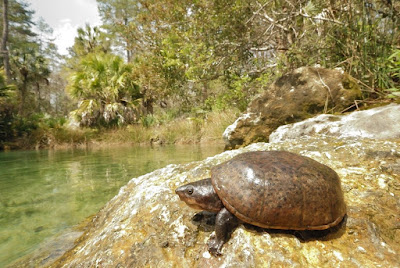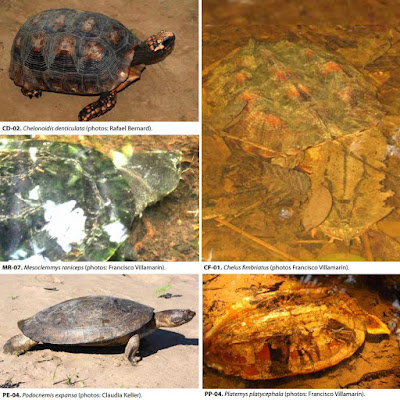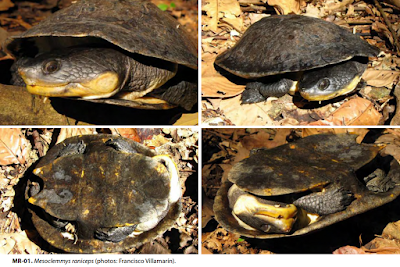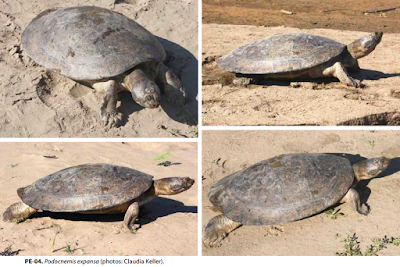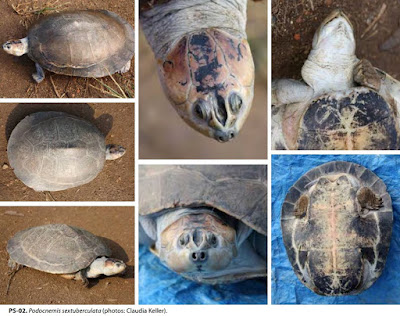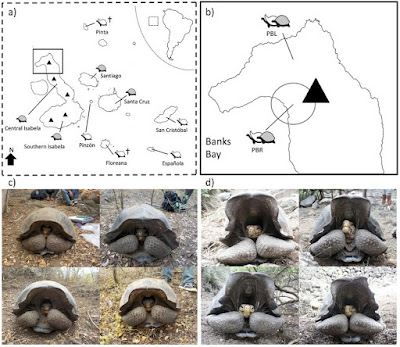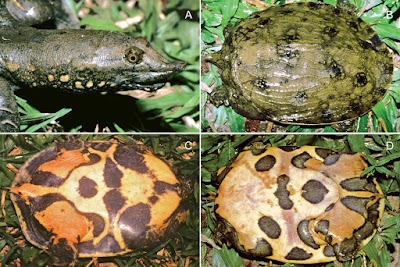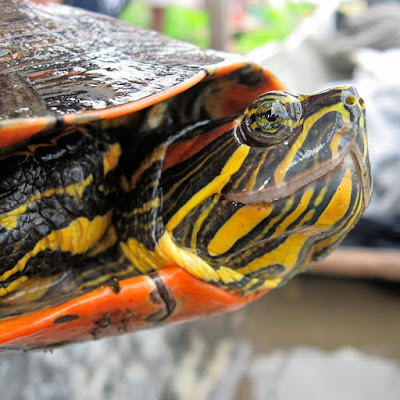 |
| Trachemys medemi Vargas-Ramírez, del Valle, Ceballos & Fritz, 2017 DOI: 10.1111/jzs.12179 |
Abstract
South America was invaded by slider turtles (Trachemys spp.) twice, with one immigration wave estimated to have reached South America 8.6–7.1 million years ago (mya) and a second wave, 2.5–2.2 mya. The two widely disjunct South American subspecies of Trachemys dorbigni (northeastern and southern Brazil, Río de la Plata region of Argentina and Uruguay) are derived from the first dispersal pulse, while the two South American subspecies of Trachemys venusta (Colombia, Venezuela) originated from the second immigration event. We describe a new species of slider turtle from the lower Atrato river basin of Antioquia and Chocó departments, northwestern Colombia. This new species, the Atrato slider (Trachemys medemi n. sp.), is the first representative of the older immigration wave inhabiting northern South America. Using phylogenetic analyses of 3,242 bp of mitochondrial and 3,396 bp of nuclear DNA, we show that T. medemi is more closely related to T. dorbigni than to the geographically neighboring subspecies of Trachemys grayi and T. venusta from Central America and northern South America. The two subspecies of T. dorbigni are separated from the Atrato slider by the Andes and the Amazon Basin, and occur approximately 4,600 km and 3,700 km distant from T. medemi. According to molecular clock calculations, T. medemi diverged from the last common ancestor of the two subspecies of T. dorbigni during the Pliocene (4.1–2.8 mya), with T. dorbigni diversifying later (2.3–1.9 mya) in eastern South America beyond the Amazon basin. The divergence of the T. dorbigni subspecies overlaps with the estimated arrival of T. venusta in South America (2.5–2.2 mya). This time is characterized by massive climatic and environmental fluctuations with intermittent dispersal corridors in South America. According to their distribution, it seems likely that the ancestors of the extant subspecies of T. dorbigni dispersed along the eastern corridor, leaving a relict population northwest of the Andes with T. medemi. The distribution range of T. medemi is surrounded by taxa derived from the second southern range expansion of slider turtles, so that it can be concluded that T. venusta circumvented the habitats occupied by the ancestors of the Atrato slider when entering South America.
 |
| Trachemys medemi n. sp., adult female (IGUN 01107), Ciénaga de Marriaga, Unguía, Chocó. Photograph: Carlos del Valle |
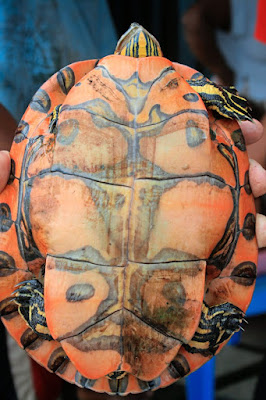 |
| Trachemys medemi n. sp., adult female (IGUN 01107), Ciénaga de Marriaga, Unguía, Chocó. Photograph: Carlos del Valle |
Trachemys medemi n. sp.
Diagnosis: In addition to its genetic distinctiveness, Trachemys medemi differs from T. scripta and West Indian slider turtles (T. decorata, T. decussata, T. stejnegeri, T. terrapen) by posterior marginal scutes without median notch; males of T. medemi also have no elongated foreclaws. Trachemys medemi differs from these species, T. gaigeae and T. nebulosa by the presence of ocelli on all costal scutes; T. gaigeae, T. nebulosa, and T. taylori possess a reticulate carapacial pattern (which may be combined with ocelli in T. taylori); a reticulate pattern is lacking in T. medemi. Trachemys grayi, T. ornata, T. venusta, and T. yaquia have never wide brick-red supratemporal stripes as T. medemi.
The two subspecies of T. dorbigni differ from T. medemi by their yellow to orange postorbital stripe, an irregular carapacial pattern with often open light wide elements and the much darker plastron with a solid dark or black central figure covering all or most of the plastron in adult turtles. Trachemys medemi differs from geographically neighboring taxa as follows: Compared to T. v. venusta, the postorbital stripe is brick-red (not yellowish or pale brownish red) and much wider, the ocellar pattern of the carapace is less distinct, and the dark plastral figure more extensive, encroaching on most of the plastron. In T. v. venusta, the plastral figure typically covers less than 30%–50% of the plastron and is normally confined to its central part. Trachemys venusta callirostris differs from T. medemi by its spotted chin pattern, a much wider dark plastral figure, and a postorbital stripe not in touch with the eye. Isolated dark plastral whorls do not occur in any of these taxa.
Derivatio nominis: We dedicate this new species with deep respect to Federico Medem (1912–1984), born as Count Friedrich Johann von Medem in Remte (then Remten), Latvia, from an old German-Baltic noble family. After his immigration to Colombia (1950), Medem contributed significantly to the development of herpetology of that country, in particular to the knowledge of turtles and crocodiles. Among others, he highlighted the distinctiveness of the Atrato slider (Medem, 1958, 1962, 1975) and provided in 1962 a most detailed morphological description that is repeated in large parts here. Among others, he highlighted that the broad brick-red postorbital stripes of the Atrato slider are a distinctive character in which it differs from its Central American relatives.
Proposed vernacular names: Atrato slider or Atrato slider turtle (English),
Pecho de Carey, Icotea del Atrato (Spanish).
Distribution: Trachemys medemi is restricted to the lower Atrato river basin, northwestern Colombia (Figure 1), with records in the following municipalities: Acandí, Unguía, Río Sucio (Departamento del Chocó), Chigorodó, and Turbo (Departamento de Antioquia). In addition, there is a questionable record for Mutatá, Antioquia. Although this site was used for developing the distribution model, Mutatá is located outside the modeled range. The local occurrence of T. medemi therefore requires confirmation.
According to Pritchard and Trebbau (1984), Federico Medem collected in the 1950s shells of “Pseudemys scripta callirostris” near the village of Necoclí (Antioquia), in a distance of less than 50 km from Turbo (Figure 1: locality 7). Based on these records, Pritchard and Trebbau (1984) suggested that the range of the Atrato slider is separated from that of T. v. callirostris by a low spur of the Cordillera that reaches the Gulf of Urabá close to Turbo. Based on our distribution model for T. medemi, which shows no overlap of the distribution ranges of the two taxa and includes Necoclí into the range of T. medemi, this record is surprising. Accordingly, also the TTWG (2017) identified this record and another one in close proximity with “T. v. venusta” (Figure 1).
Conservation: Although turtle populations within the Natural Park Los Katíos and the National Protected Forest Reserve Río León are protected, T. medemi faces serious conservation problems elsewhere. Several threats have been identified. Intense illegal trade is known at least from 1982 to the present (Castaño-Mora, 1992; Ceballos & Brand, 2014). Thousands of sliders are annually collected for human consumption during the Holy Week, and this refers to T. medemi and T. v. callirostris. Forest burning to create pastures for livestock has also been reported as a threat (Bock et al., 2012; Ceballos & Brand, 2014). Until the conservation status of T. medemi is examined in more detail, we recommend to include it into the category “Vulnerable” of the IUCN Red List of Threatened Species because (i) T. medemi is a unique and endemic species of the turtle fauna of Colombia and South America; (ii) it is threatened by overexploitation; and (iii) it is confined to a small distribution range.
Mario Vargas-Ramírez, Carlos del Valle, Claudia P. Ceballos and Uwe Fritz. 2017. Trachemys medemi n. sp. from northwestern Colombia turns the Biogeography of South American Slider Turtles Upside Down. Journal of Zoological Systematics and Evolutionary Research. 55(4); 326–339. DOI: 10.1111/jzs.12179
Neue Schmuckschildkröte in Kolumbien entdeckt derstandard.at/2000065562274/Neue-Schmuckschildkroete-in-Kolumbien-entdeckt @derStandardat
Nueva especie de tortuga fue hallada en las colecciones biológicas del Instituto Humboldt en Villa de Leyva, Boyacá.
La tortuga dulceacuícola (Trachemys medemi) proveniente de la región del Pacífico, es proveniente de Río Sucio, Chocó, Parque Nacional Natural Los Katıos, Colombia y fue colectada en los años 70. Está contribución fue producto de la visita y trabajo colaborativo del Museo de Historia Natural de Senckenberg de Alemania y el Instituto de Genética de la Universidad Nacional a los colecciones biológicas del Instituto el año pasado en el cual nuestros colegas Mario Vargas (UNal) y Uwe Fritz (Senckenberg) son los autores.
We describe a new species of slider turtle from the lower Atrato river basin of Antioquia and Chocó departments, northwestern Colombia. Using phylogenetic analyses of 3,242 bp of mitochondrial and 3,396 bp of nuclear DNA, we show that this new species, the Atrato slider (Trachemys medemi n. sp.), is more closely related to Trachemys dorbigni than to the geographically neighbouring subspecies of Trachemys grayi and Trachemys venusta from Central America and northern South America.
---------------------------------------------------------------
روابط التحميل والمشاهدة، الروابط المباشرة للتحميل
او
شاهد هذا الفيديو القصير لطريقة التحميل البسيطة
كيف تحصل على مدونة جاهزة بآلاف المواضيع والمشاركات من هنا
شاهد قناة منتدى مدونات بلوجر جاهزة بألاف المواضيع والمشاركات على اليوتيوب لمزيد من الشرح من هنا
رابط مدونة منتدى مدونات بلوجر جاهزة بآلاف المواضيع والمشاركات في أي وقت حــــتى لو تم حذفها من هنا
شاهد صفحة منتدى مدونات بلوجر جاهزة بألاف المواضيع والمشاركات على الفيس بوك لمزيد من الشرح من هنا
شاهد صفحة منتدى مدونات بلوجر جاهزة بألاف المواضيع والمشاركات على الفيس بوك لمزيد من الشرح من هنا
تعرف على ترتيب مواضيع منتدى مدونات بلوجر جاهزة بآلاف المواضيع والمشاركات (حتى لا تختلط عليك الامور) من هنا
ملاحظة هامة: كل عمليات تنزيل، رفع، وتعديل المواضيع الجاهزة تتم بطريقة آلية، ونعتذر عن اي موضوع مخالف او مخل بالحياء مرفوع بالمدونات الجاهزة بآلاف المواضيع والمشاركات، ولكم ان تقوموا بحذف هذه المواضيع والمشاركات والطريقة بسيطة وسهلة. ــــــــــــــــــــــــــــــــــــــــــــــــــــــــــــــــــــــــــــــسلامـ.






